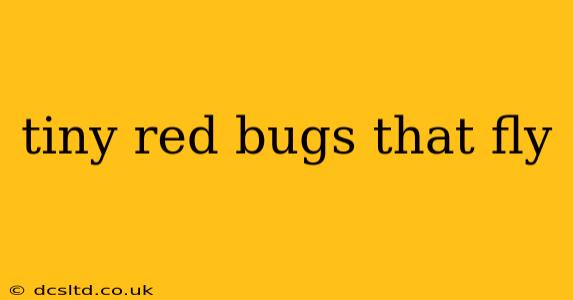Tiny red flying bugs can be a nuisance, invading homes and gardens alike. Identifying the specific species is crucial for effective control. This guide explores common culprits, their characteristics, and methods for managing infestations. We'll delve into frequently asked questions to provide a complete understanding of these pesky insects.
What are some common types of tiny red flying bugs?
Several insects fit this description, and accurate identification depends on size, behavior, and location. Some possibilities include:
-
Minute Pirate Bugs (Orius insidiosus): These tiny, black and red bugs are beneficial insects, preying on other pests like mites and thrips. While they might bite humans, the bite is generally harmless.
-
Red Spider Mites (Tetranychidae): Though technically mites (arachnids, not insects), these tiny creatures are often mistaken for insects. They're usually found in large colonies on plants and are notorious for damaging foliage. They're not technically flying insects, but their webs can make them appear airborne.
-
Fungus Gnats (Sciaridae): These small, dark-colored gnats are often found around moist soil, particularly in houseplants. While they don't bite, their presence can indicate overwatering.
-
Chiggers (Trombiculidae): These microscopic mites are not technically flying but can appear to be because of their movement through the air in vegetation. Their bites cause severe itching. They are typically found in grassy areas.
-
Various Flies: Several species of tiny red flies exist, often depending on your geographic location and environment. Identifying these requires a closer look at their physical characteristics, such as wing venation and body shape. Examples might include certain species of midges or fruit flies with red markings.
How do I get rid of tiny red flying bugs in my house?
The best method depends on the type of insect. However, some general approaches are effective for many species:
-
Identify the source: Find where the bugs are breeding or entering your home. This could be stagnant water, decaying organic matter, or overwatered plants.
-
Cleanliness is key: Regularly clean your home, paying attention to areas where insects might congregate, such as kitchens and bathrooms. Vacuum frequently to remove any insects and their eggs.
-
Seal entry points: Caulk cracks and crevices in walls and windows to prevent insects from entering.
-
Use traps: Sticky traps can be effective for catching small flying insects. For fungus gnats, consider using yellow sticky traps.
-
Consider natural remedies: Diatomaceous earth can be used as a natural insecticide, and certain essential oils (like peppermint or tea tree oil) may deter some insects. Always follow usage instructions carefully.
-
Professional pest control: If you're struggling to control the infestation, it's always best to contact a professional pest control service. They have the expertise and tools to identify and eliminate the problem effectively.
How do I get rid of tiny red flying bugs in my garden?
Garden pests often require different control methods:
-
Beneficial insects: Introduce natural predators like ladybugs or lacewings, which prey on many common garden pests.
-
Neem oil: This organic insecticide is effective against many types of insects and is relatively safe for plants and beneficial insects.
-
Insecticidal soap: Another safe option, insecticidal soap effectively controls soft-bodied insects.
-
Water sprays: A strong jet of water can knock off many insects from plants.
-
Proper watering techniques: Avoid overwatering to prevent conditions that attract fungus gnats and other pests.
-
Crop rotation: Rotating your crops can help to disrupt the life cycle of pest insects.
What attracts tiny red flying bugs?
The attraction varies depending on the specific insect:
-
Food sources: Some insects are attracted to decaying organic matter, sugary substances, or specific plants.
-
Moisture: Many insects prefer damp environments. Standing water, leaky pipes, and overwatered plants can all attract insects.
-
Light: Some insects are attracted to light, which can lead them indoors.
-
Specific plants: Certain plants can be more attractive to certain insects than others.
Are tiny red flying bugs dangerous?
Most tiny red flying bugs are not dangerous to humans. However, some, like chiggers, can bite and cause itching. Others might carry diseases, though this is less common with these smaller species. Always err on the side of caution, and if you experience an allergic reaction or persistent discomfort after an insect bite, consult a medical professional.
By understanding the types of tiny red flying bugs and implementing the appropriate control measures, you can effectively manage infestations and protect your home and garden. Remember, accurate identification is crucial for successful pest control.
